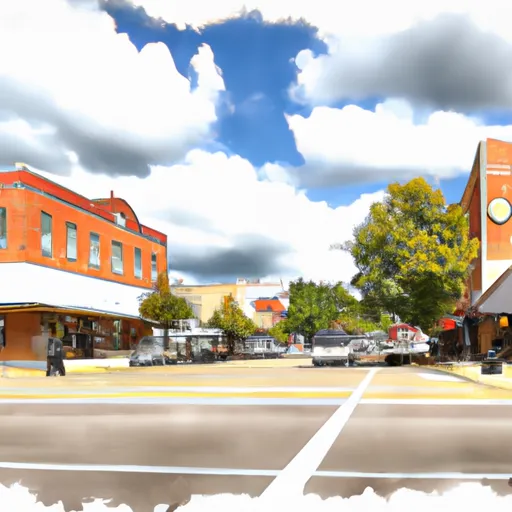-
 Snoflo Premium
Snoflo Premium
Get unlimited access to all our content
With no Ad interruptions! - Start Your Free Trial Login with existing account
Clarksville
Eden Index
Climate
8.0
•
Recreation
4.0
•
Community
2.0
•
Safeguard
5.1/10

Clarksville, Arkansas is a city located in the Ozark Mountains with a humid subtropical climate. Summer temperatures can reach up to 90°F, while winter temperatures can drop to the 30s. The city is situated near the Arkansas River, which is a major source of water for the area. However, the water quality can be affected by agricultural runoff and industrial discharges. Outdoor recreation opportunities in Clarksville include hiking in the nearby Ozark National Forest and exploring the local caves. The Arkansas River also provides opportunities for fishing and boating. Additionally, the city hosts an annual Johnson County Peach Festival that celebrates local agriculture and culture.
What is the Eden Index?
The Snoflo Eden Index serves as a comprehensive rating system for regions, evaluating their desirability through a holistic assessment of climate health, outdoor recreation opportunities, and natural disaster risk, acknowledging the profound impact of these factors on livability and well-being.
Climate Health Indicator (CHI): 8.0
Clarksville receives approximately
1235mm of rain per year,
with humidity levels near 89%
and air temperatures averaging around
16°C.
Clarksville has a plant hardyness factor of
7, meaning
plants and agriculture in this region tend to thrive during the non-winter months.
By considering the ideal temperature range, reliable water supplies, clean air, and stable seasonal rain or snowpacks, the Climate Health Indicator (CHI) underscores the significance of a healthy climate as the foundation for quality living.
A healthy climate is paramount for ensuring a high quality of life and livability in a region, fostering both physical well-being and environmental harmony. This can be characterized by ideal temperatures, reliable access to water supplies, clean air, and consistent seasonal rain or snowpacks.
Weather Forecast
Streamflow Conditions
Lower Arkansas-Fourche La Fave
Area Rivers
Lower Arkansas-Fourche La Fave
Snowpack Depths
Lower Arkansas-Fourche La Fave
Reservoir Storage Capacity
Lower Arkansas-Fourche La Fave
Groundwater Levels
Recreational Opportunity Index (ROI): 4.0
The Recreational Opportunity Index (ROI) recognizes the value of outdoor recreational options, such as parks, hiking trails, camping sites, and fishing spots, while acknowledging that climate plays a pivotal role in ensuring the comfort and consistency of these experiences.
Access to outdoor recreational opportunities, encompassing activities such as parks, hiking, camping, and fishing, is crucial for overall well-being, and the climate plays a pivotal role in enabling and enhancing these experiences, ensuring that individuals can engage in nature-based activities comfortably and consistently.
Camping Areas
| Campground | Campsites | Reservations | Toilets | Showers | Elevation |
|---|---|---|---|---|---|
| South Abutment East | 12 | 177 ft | |||
| Cypress Black Bayou Rec Area | None | 207 ft | |||
| Teague Lake Primitive | None | 199 ft | |||
| Lake Bistineau State Park | None | 170 ft | |||
| Barksdale AFB Military | None | 160 ft | |||
| Harmon Lake Dam - Barksdale AFB | 6 | 222 ft | |||
| Highway 157 Primitive | None | 203 ft | |||
| Ivan Lake | 4 | 212 ft | |||
| Frank Anthony RV Park | 30 | 242 ft | |||
| Turtle Slide | None | 223 ft |
Nearby Ski Areas
Catastrophe Safeguard Index (CSI):
The Catastrophe Safeguard Index (CSI) recognizes that natural disaster risk, encompassing floods, fires, hurricanes, and tornadoes, can drastically affect safety and the overall appeal of an area.
The level of natural disaster risk in a region significantly affects safety and the overall livability, with climate change amplifying these risks by potentially increasing the frequency and intensity of events like floods, fires, hurricanes, and tornadoes, thereby posing substantial challenges to community resilience and well-being.
Community Resilience Indicator (CRI): 2.0
The Community Resilience Indicator (CRI) recognizes that education, healthcare, and socioeconomics are crucial to the well-being of a region. The CRI acknowledges the profound impact of these elements on residents' overall quality of life. By evaluating educational resources, healthcare accessibility, and economic inclusivity, the index captures the essential aspects that contribute to a thriving community, fostering resident satisfaction, equity, and social cohesion.

